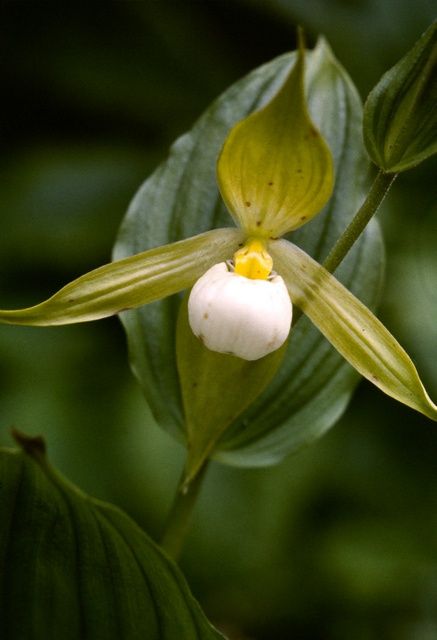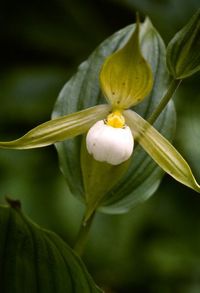
Plants terrestrial, stems less than lm tall, rhizomatous. Leaves 1 to several, plicate, deciduous, reniform- ovate to lanceolate. Inflorescence terminal, 1- to several-flowered; peduncle short to long; floral bracts leafy. Flowers showy. Dorsal sepal erect or porrect over lip; lateral sepals united to form a synsepal. Petals spreading, linear-lanceolate, sometimes twisted. Lip deeply saccate, margins inrolled. Column porrect; staminode peltate-ovate to trowel-shaped; anthers 2, behind staminode.
The genus Cypripedium was established in 1753 by Linnaeus, in the first edition of his Species Plantarum. A revision of the genus, with sectional delimitation and full synonymy, can be found in Cribb (1997). The genus comprises about 47 species widely distributed in N America south to Mexico, Guatemala and Honduras, Europe, temperate Asia, Taiwan and Japan.
Most species of the genus are pollinated by various species of small bee (Andrenidae, Megachilidae or Halictidae) while the large N American C. acaule Aiton is pollinated by bumble-bee queens. Vogt (1990) reports syrphid flies and flower beetles as the pollinators of the N American species C. reginae Walter. The slipper orchid flower is a one-way trap that offers no reward. The pollinating insects, probably young and naive, are attracted to- the flower by deceit. The insects enter by the orifice of the slipper-shaped lip in front of the staminode and, after falling into it, can only crawl out beneath the stigma and anthers, emerging at the base of the column through one of two small orifices. After a few visits the insects learn to avoid the flower which may explain the low pollination rate in some species.
lectotype. Cypripedium calceolus L.
etymology. Named from the Greek Cypros (Cyprus), the island sacred to Venus, and the Greek pedion (slipper), a reference to the popular name of Venus’ slipper orchid.
The genus Cypripedium was established in 1753 by Linnaeus, in the first edition of his Species Plantarum. A revision of the genus, with sectional delimitation and full synonymy, can be found in Cribb (1997). The genus comprises about 47 species widely distributed in N America south to Mexico, Guatemala and Honduras, Europe, temperate Asia, Taiwan and Japan.
Most species of the genus are pollinated by various species of small bee (Andrenidae, Megachilidae or Halictidae) while the large N American C. acaule Aiton is pollinated by bumble-bee queens. Vogt (1990) reports syrphid flies and flower beetles as the pollinators of the N American species C. reginae Walter. The slipper orchid flower is a one-way trap that offers no reward. The pollinating insects, probably young and naive, are attracted to- the flower by deceit. The insects enter by the orifice of the slipper-shaped lip in front of the staminode and, after falling into it, can only crawl out beneath the stigma and anthers, emerging at the base of the column through one of two small orifices. After a few visits the insects learn to avoid the flower which may explain the low pollination rate in some species.
lectotype. Cypripedium calceolus L.
etymology. Named from the Greek Cypros (Cyprus), the island sacred to Venus, and the Greek pedion (slipper), a reference to the popular name of Venus’ slipper orchid.



